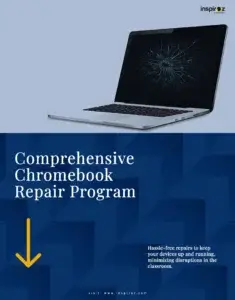As charter schools strive to provide a high-quality, individualized education to students, technology has become a critical enabler of learning.
One of the most talked-about models is the 1:1 student-to-device ratio, where each student has access to their own dedicated device, typically a laptop or tablet, throughout the school day.
However, the decision to implement a 1:1 ratio is not straightforward. It requires balancing educational needs, financial considerations, infrastructure capabilities, and long-term sustainability.
Understanding the 1:1 Student-To-Device Ratio
The 1:1 ratio is grounded in the belief that every student benefits from equal access to technology, which promotes personalized learning and helps close the digital divide. By ensuring each student has their own device, schools aim to create an environment where learning can happen anywhere, anytime.
Many schools have adopted this model to provide students with laptops, Chromebooks, or tablets to enhance their educational experience. But, like any investment in educational technology, a 1:1 ratio comes with both advantages and challenges.
Benefits of a 1:1 Student-To-Device Ratio
Personalized Learning : One of the primary advantages of a 1:1 device ratio is its ability to foster personalized learning experiences. With each student having access to their own device, teachers can tailor their instruction to meet individual learning styles, paces, and needs.
Adaptive learning software allows students to work through assignments at their own pace, while teachers can track progress and intervene when necessary.
In addition, digital tools like educational apps, simulations, and online research materials provide a wide variety of resources for different learning preferences, helping to engage students more effectively.
Enhanced Student Engagement : Technology can be a powerful engagement tool, particularly for students who struggle to stay focused in traditional classroom settings.
Devices also enable collaboration through tools like Google Classroom or Microsoft Teams, where students can work together on projects and engage in discussions, even beyond the classroom.
Streamlined Assessments and Data Collection : Digital devices simplify the process of administering assessments and collecting student data. Teachers can use software to give quizzes, track progress, and analyze performance in real time.
This makes it easier to identify learning gaps and implement targeted interventions. Moreover, automated grading tools save time and allow teachers to focus on more meaningful interactions with students.
Inspiroz advanced data analytics helps educators not only track real-time progress but also uncover patterns and trends that may otherwise go unnoticed. This enables schools to implement more effective, data-driven interventions and customize learning experiences.
Challenges of a 1:1 Student-To-Device Ratio
- Financial Constraints
Implementing and maintaining a 1:1 device ratio can be expensive. Charter schools often operate with limited budgets, and the cost of purchasing devices, software licenses, and accessories like charging stations or protective cases adds up quickly.
Beyond the initial investment, schools must account for ongoing costs, including technical support, repairs, and eventual device replacements.
Schools may need to explore creative financing options or partnerships to make the 1:1 model feasible.
Inspiroz, for instance, can help schools leverage cost-effective solutions by offering partnerships with key technology vendors such as Lenovo Education, Google Workspace, and Dell, providing schools with access to affordable, high-quality devices and software.
- Device Maintenance and Support
Managing a fleet of devices requires a robust IT infrastructure and dedicated technical support staff. Devices will inevitably break down or malfunction, and without proper maintenance, the effectiveness of the 1:1 program can be compromised.
Schools need a plan for device repair, troubleshooting, and replacement, as well as a system for distributing updated software and handling cybersecurity concerns.

Inspiroz provides comprehensive IT support, ensuring that your school’s devices remain functional and secure. Schools can rely on Inspiroz’s expertise in Chromebook repair services and ongoing maintenance, which minimizes downtime and maximizes device longevity.
- Equity and Access
While the 1:1 model aims to close the digital divide, it doesn’t automatically solve all issues related to access. Some students may not have reliable internet access at home, making it difficult for them to fully benefit from their devices outside of school.
Schools considering a 1:1 ratio must ensure that all students have access to the internet and resources they need, both on and off-campus.
Inspiroz partners with network solutions providers, including GoGuardian and Microsoft, to offer internet filtering and Wi-Fi hotspot solutions that extend access beyond the classroom.
This helps bridge the gap for students who may not have stable internet access at home, ensuring equitable access to learning resources.
- Teacher Training and Support
Even with the best technology, a 1:1 program can fall short without adequate teacher training.
Teachers must be comfortable with the devices, tools, and software they’re using in the classroom to maximize their effectiveness. Professional development is crucial to help educators integrate technology into their lesson plans and leverage digital tools for meaningful student engagement.
Inspiroz works closely with schools to deliver tailored professional development sessions, helping teachers become proficient in using platforms such as Google Workspace for Education and PowerSchool.
Through these partnerships, Inspiroz ensures that teachers are equipped with the necessary skills and confidence to make the most of the technology available to them.
- Potential for Distraction
Devices can sometimes introduce distractions into the classroom. Without proper management, students may use their devices for non-educational purposes, such as gaming or browsing social media.
Schools need clear guidelines for acceptable device use and tools to monitor and limit off-task behavior. In many cases, schools use software that restricts certain websites or activities during class time.
- Making the Right Decision for Your School
Whether a 1:1 student-to-device ratio is right for your charter school depends on a variety of factors, including your school’s educational goals, financial resources, and technological infrastructure.
Before making a decision, consider the following steps:
Assess Educational Needs : Consider how technology will support your school’s instructional goals. Are there particular programs or initiatives, like personalized learning or STEM education, that would benefit from a 1:1 ratio?
Evaluate whether the benefits of individualized access outweigh the costs for your specific student population.
Evaluate Infrastructure and Support Systems : Does your school have the necessary infrastructure to support a 1:1 model?
This includes a robust Wi-Fi network, adequate bandwidth, technical support, and systems for device management and maintenance. A lack of infrastructure can derail even the most well-intentioned 1:1 program.
Analyze Financial Feasibility : Work with your finance team to create a budget for a 1:1 program, factoring in not only the cost of devices but also long-term maintenance, repairs, and replacements.
Inspiroz can assist schools in device procurement by leveraging its partnerships with leading vendors such as Lenovo, Dell, Microsoft, etc,. helping you secure high-quality devices at competitive prices.
Additionally, Inspiroz offers comprehensive device maintenance services, ensuring your devices remain functional throughout their lifecycle and minimizing costly downtime due to repairs or technical issues.
Plan for Professional Development : Ensure that your teachers are prepared to integrate technology into their classrooms.
Develop a comprehensive professional development plan that includes training on device usage, instructional software, and digital classroom management. Regularly provide opportunities for teachers to update their skills and share best practices with colleagues.
Pilot the Program: Consider starting with a pilot program to test the effectiveness of a 1:1 ratio on a smaller scale. This allows you to identify potential issues and gather feedback from students, teachers, and parents before rolling out the program school-wide.







